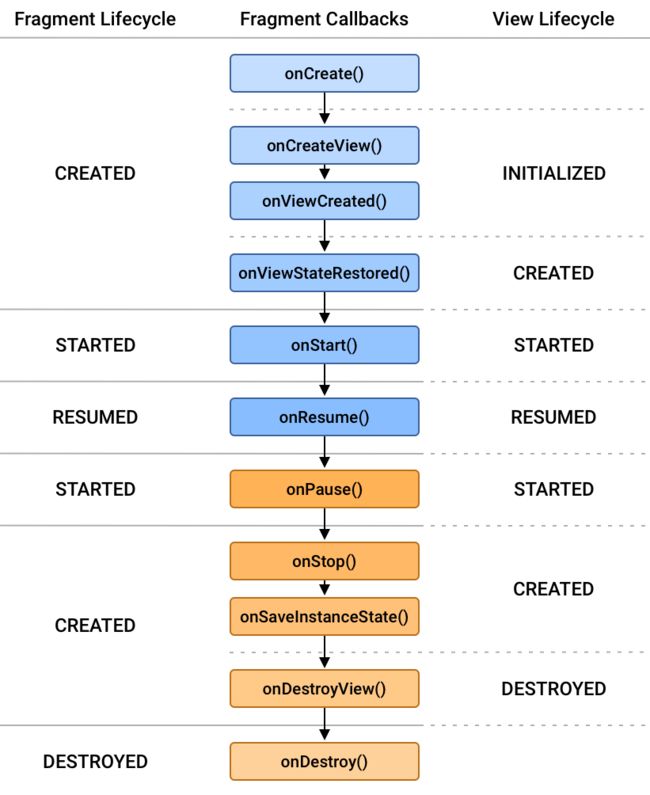自学Android开发 Fragment的onActivityCreated()被弃用
目录
一、Fragment的生命周期
1、Lifecycle状态及其与Fragment生命周期回调
二、onActivityCreated的弃用
1、官方更新文档
2、onViewCreated()和onCreateView()
2.1、onCreateView()源码
2.2、onViewCreated()源码
三、onActivityCreated方法
四、onActivityCreated弃用后的替代方案
1、替代方案
2、通过Lifecycles获取Activity的onCreate()事件
五、Handling Lifecycles
1、Handling Lifecycles
2、LifecycleObserver
3、LifecycleOwner
一、Fragment的生命周期
1、Lifecycle状态及其与Fragment生命周期回调
注意:onAttach()始终在任何Lifecycle 状态更改之前调用,所以onAttach()在onCreate()之前调用。
二、onActivityCreated的弃用
1、官方更新文档
版本 1.3.0-alpha02
2020 年 3 月 18 日
发布了
androidx.fragment:fragment:1.3.0-alpha02、androidx.fragment:fragment-ktx:1.3.0-alpha02和androidx.fragment:fragment-testing:1.3.0-alpha02。。新功能
- 添加了对 Activity 1.2.0-alpha02 中引入的 ActivityResultRegistry API 的支持,让您无需覆盖 Fragment 中的方法,即可处理 startActivityForResult()+onActivityResult() 以及 requestPermissions()+onRequestPermissionsResult() 流程,并提供用于测试这些流程的钩子。请参阅更新后的获取 Activity 的结果一文。
API 变更
DialogFragment现在提供了一个采用@LayoutRes的构造函数,后者用于指明默认情况下onCreateView()应该膨胀的布局。onActivityCreated()方法现已弃用。与 Fragment 视图有关的代码应在onViewCreated()(在onActivityCreated()之前调用)中执行,而其他初始化代码应在onCreate()中执行。如需专门在 Activity 的onCreate()完成时接收回调,应在onAttach()中的 Activity 的Lifecycle上注册LifeCycleObserver,并在收到onCreate()回调后将其移除。bug 修复
从 Fragment 1.2.3 开始:修复了从 onCreateDialog() 内调用 getLayoutInflater() 时,DialogFragment 中导致 StackOverflowError 的错误。
- 从 Fragment 1.2.3 开始:缩小了 Fragment 包含的 ProGuard 规则的范围,以确保可以剥离未使用的 Fragment 类。
- 从 Fragment 1.2.3 开始:修复了在使用覆盖 Kotlin 属性名称的局部变量名称时,UseRequireInsteadOfGet Lint 检查中的误报问题。
- 从 Fragment 1.2.3 开始:FragmentContainerView 不再因为在布局预览中使用不正确的构造函数而抛出 UnsupportedOperationException。
已知问题
BottomSheetDialogFragment无法再在屏幕上正确定位其对话框。
2、onViewCreated()和onCreateView()
通过最新的Fragment的生命周期图可知onViewCreated()是在onCreateView()之后调用;
2.1、onCreateView()源码
/**
* Called to have the fragment instantiate its user interface view.
* This is optional, and non-graphical fragments can return null. This will be called between
* {@link #onCreate(Bundle)} and {@link #onViewCreated(View, Bundle)}.
* A default View can be returned by calling {@link #Fragment(int)} in your
* constructor. Otherwise, this method returns null.
*
*
It is recommended to only inflate the layout in this method and move
* logic that operates on the returned View to {@link #onViewCreated(View, Bundle)}.
*
*
If you return a View from here, you will later be called in
* {@link #onDestroyView} when the view is being released.
*
* @param inflater The LayoutInflater object that can be used to inflate
* any views in the fragment,
* @param container If non-null, this is the parent view that the fragment's
* UI should be attached to. The fragment should not add the view itself,
* but this can be used to generate the LayoutParams of the view.
* @param savedInstanceState If non-null, this fragment is being re-constructed
* from a previous saved state as given here.
*
* @return Return the View for the fragment's UI, or null.
*/
@MainThread
@Nullable
public View onCreateView(@NonNull LayoutInflater inflater, @Nullable ViewGroup container,
@Nullable Bundle savedInstanceState) {
if (mContentLayoutId != 0) {
return inflater.inflate(mContentLayoutId, container, false);
}
return null;
}
注释翻译
/**
* 调用以使片段实例化其用户界面视图。
* 这是可选的,非图形片段可以返回 null。这将在
* {@link #onCreate(Bundle)} 和 {@link #onViewCreated(View, Bundle)}。
*可以通过调用 {@link #Fragment(int)} 返回默认视图
* 构造函数。否则,此方法返回 null。
*
*建议在此方法中只膨胀布局并移动
* 对返回的视图进行操作的逻辑 {@link #onViewCreated(View, Bundle)}。
*
*如果你从这里返回一个视图,你以后会被调用
* {@link #onDestroyView} 当视图被释放时。
*
* @param inflater 可用于膨胀的 LayoutInflater 对象
* 片段中的任何视图,
* @param container 如果非空,这是片段的父视图
* UI 应附加到。该片段不应添加视图本身,
* 但这可用于生成视图的 LayoutParams。
* @param savedInstanceState 如果非空,则此片段正在重新构造
* 来自此处给出的先前保存的状态。
*
* @return 返回片段 UI 的视图,或者为 null。
*/
注意:在使用LayoutInflater inflater实例化视图时,建议使用inflater.inflate(R.layout.xxx,container,false),不建议把ViewGroup 置null(inflater.inflate(R.layout.xxx,null,false))
2.2、onViewCreated()源码
/**
* Called immediately after {@link #onCreateView(LayoutInflater, ViewGroup, Bundle)}
* has returned, but before any saved state has been restored in to the view.
* This gives subclasses a chance to initialize themselves once
* they know their view hierarchy has been completely created. The fragment's
* view hierarchy is not however attached to its parent at this point.
* @param view The View returned by {@link #onCreateView(LayoutInflater, ViewGroup, Bundle)}.
* @param savedInstanceState If non-null, this fragment is being re-constructed
* from a previous saved state as given here.
*/
@MainThread
public void onViewCreated(@NonNull View view, @Nullable Bundle savedInstanceState) {
}
注释翻译
/**
* 在 {@link #onCreateView(LayoutInflater, ViewGroup, Bundle)} 之后立即调用
* 已经返回,但在任何保存的状态恢复到视图之前。
* 这给了子类一次初始化自己的机会
* 他们知道他们的视图层次结构已经完全创建。 片段的
* 然而,此时视图层次结构并未附加到其父级。
* @param view {@link #onCreateView(LayoutInflater, ViewGroup, Bundle)} 返回的视图。
* @param savedInstanceState 如果非空,则此片段正在重新构造
* 来自此处给出的先前保存的状态。
*/
提示:一般onCreateView()用于初始化Fragment的视图,onViewCreated()一般用于初始化视图内各个控件,而onCreate()用于初始化与Fragment视图无关的变量。
三、onActivityCreated方法
onActivityCreated()是在宿主Activity的onCreate()完成之后立即调用,这也确保了宿主Activity的视图是完成了初始化。当然在这个方法内也可以操作宿主Activity视图的控件View或者获知其他Fragment。
执行该方法时,与Fragment绑定的Activity的onCreate()方法已经执行完成并返回,在onActivityCreated()内可以进行与Activity交互的UI操作,所以在onActivityCreated()之前Activity的onCreate方法并未执行完成,如果提前进行交互操作,会引发空指针异常。
在旧的的API中onActivityCreated()常用用于初始化非静态的VIew控件(自定义VIew),静态控件不一定在onActivityCreated()中初始化,在onCreateView()和onViewCreated()中初始化非静态的VIew控件都是错误的操作。
四、onActivityCreated弃用后的替代方案
1、替代方案
谷歌为了管理Fragment的生命周期,实现了 LifecycleOwner,暴露了一个Lifecycle你可以通过getLifecycle() 方法访问的对象 。
因为onActivityCreated()是宿主Activity的onCreate()之后立即调用,所以可以在onAttach的时候,通过订阅Activity的lifecycle来获取Activity的onCreate()事件,记得要removeObserver。
2、通过Lifecycles获取Activity的onCreate()事件
@Override
public void onAttach(@NonNull @NotNull Context context) {
super.onAttach(context);
//requireActivity() 返回的是宿主activity
requireActivity().getLifecycle().addObserver(new LifecycleEventObserver() {
@Override
public void onStateChanged(@NonNull @NotNull LifecycleOwner source, @NonNull @NotNull Lifecycle.Event event) {
if (event.getTargetState() == Lifecycle.State.CREATED){
//在这里任你飞翔
requireActivity().getLifecycle().removeObserver(this); //这里是删除观察者
}
}
});
}提示:
/** * Created state for a LifecycleOwner. For an {@link android.app.Activity}, this state * is reached in two cases: **
*/ CREATED,- after {@link android.app.Activity#onCreate(android.os.Bundle) onCreate} call; *
- right before {@link android.app.Activity#onStop() onStop} call. *
注释翻译:
/**
* 为 LifecycleOwner 创建状态。 对于 {@link android.app.Activity},此状态
* 在两种情况下达到:
*
*- {@link android.app.Activity#onCreate(android.os.Bundle) onCreate} 调用之后;
*- 就在 {@link android.app.Activity#onStop() onStop} 调用之前。
*
*/
3、onViewCreated()
在普通一般初始化View 时 已经可以替代onActivityCreated();
五、Handling Lifecycles
1、Handling Lifecycles
包含:
- Lifecycle
- LifecycleObserver
- LifecycleOwner
2、LifecycleObserver
- 具有Android生命周期的接口
- 可以处理生命周期带来的变化却不需要在Activity或者Fragment中实现任何代码。
3、LifecycleOwner
- 这是一个接口,用于将一个类标记为LifecycleObserver
- 接口里面没有任何方法,而是依赖于 {@lOnLifecycleEvent}注释方法。
如果对您有一些意义,希望您给博主一些鼓励(点赞、关注、收藏),如果有错误欢迎大家评论。
